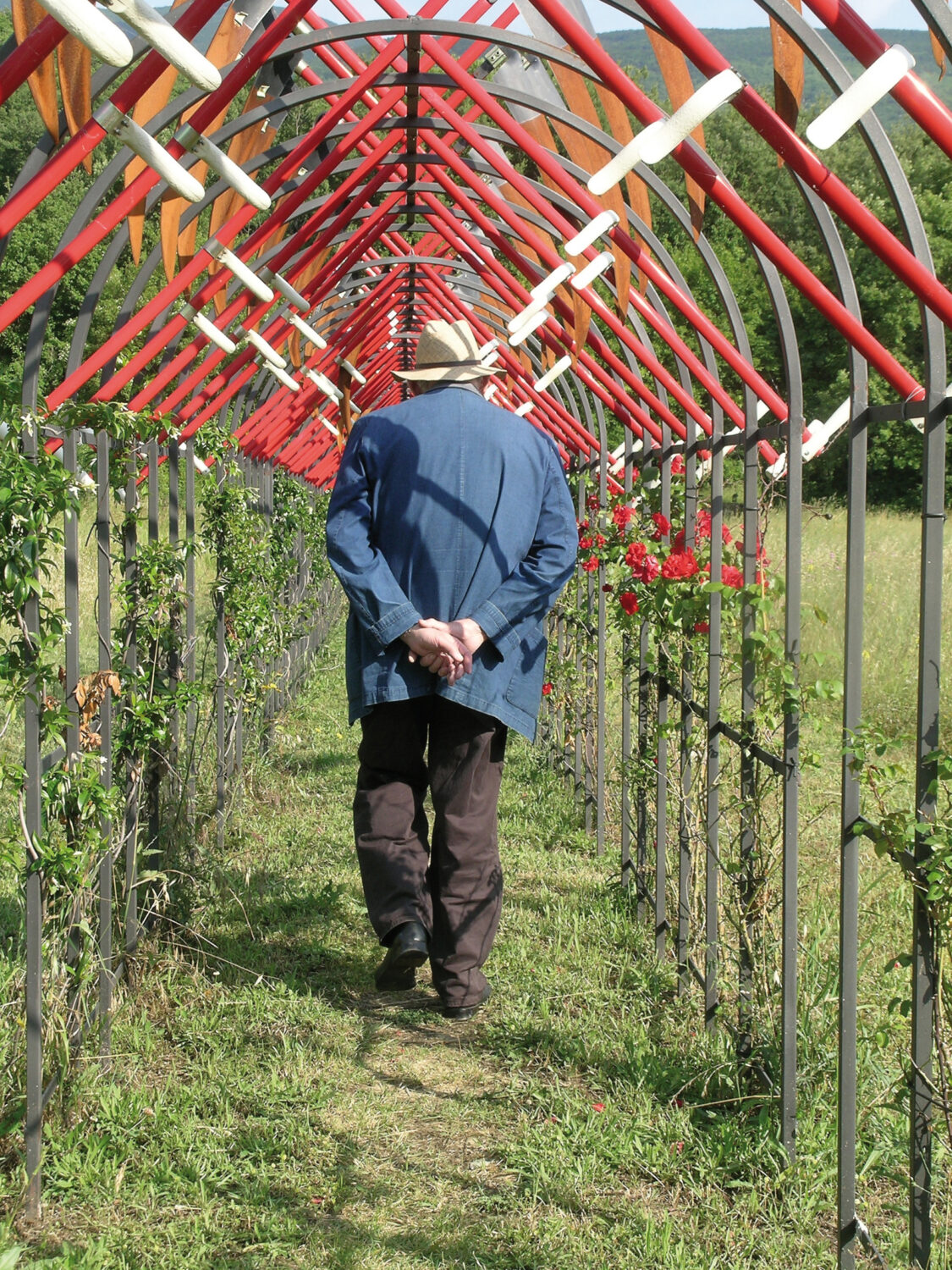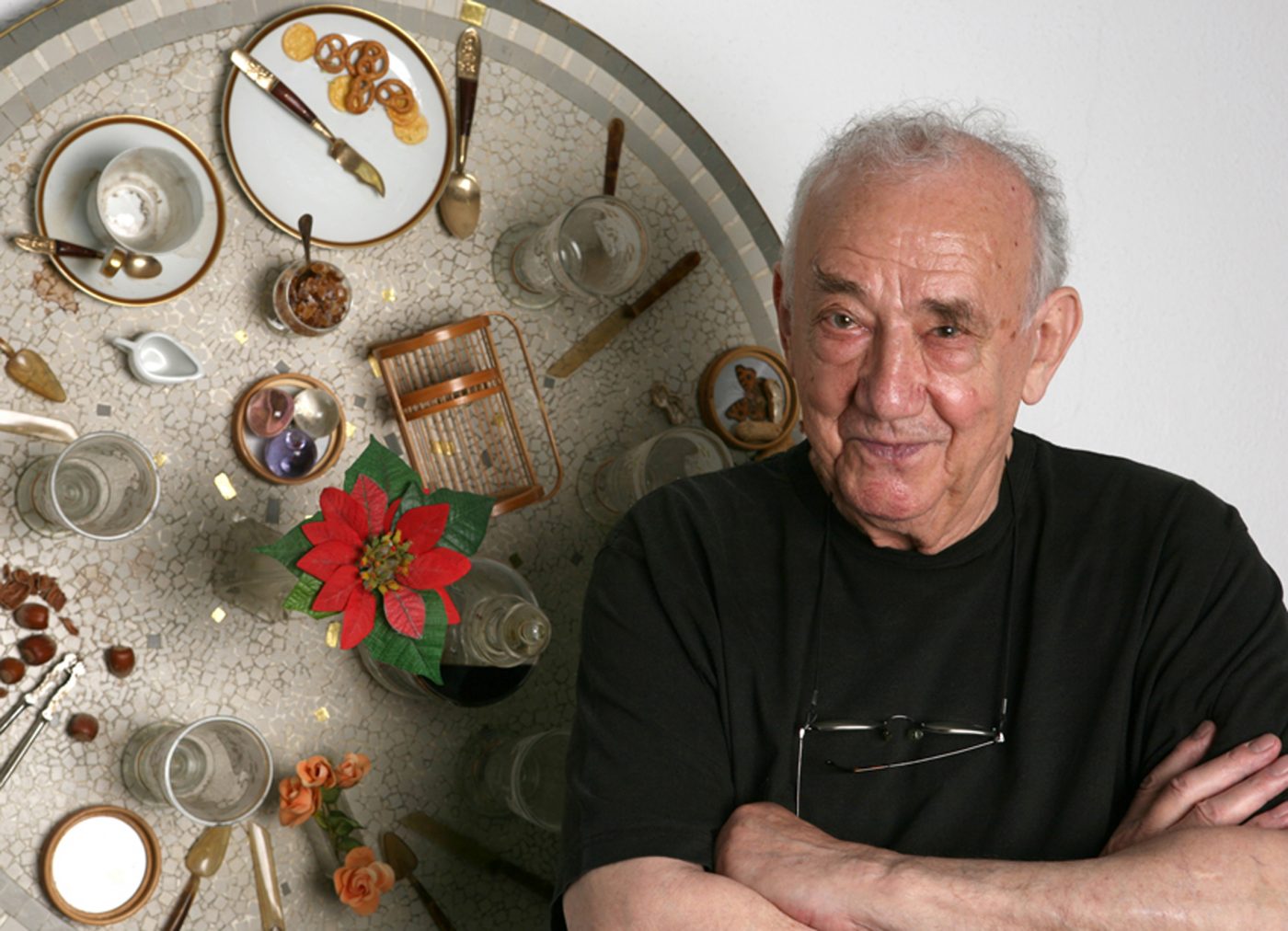
UBITUARY for DANIEL SPOERRI
March 27, 1930 – November 6, 2024
The great personalities who have marked history, in this case the history of art, through an indomitable creativity and curiosity, never dormant throughout their long career, remain in the heart and their example is never completely lost.
This is how the Foundation “Hic Terminus Haeret – Il Giardino di Daniel Spoerri” feels towards Daniel Spoerri, creator and director of this special park and a great protagonist of the international art scene since the post-war period, announcing with great sadness and a thought of deep affection that yesterday, November 6, 2024, Daniel Spoerri left us.
We want to imagine him, with his ironic, irreverent and profound attitude, as a perennial guardian angel who will watch over this unique place in the world, a three-dimensional autobiography that contains thoughts and many testimonies of his poetics. Have a good trip Daniel, towards “infinity and beyond”, and never forget your Garden!
BIOGRAPHICAL NOTES
Daniel Spoerri (his original paternal surname was Feinstein) was perhaps the greatest objector after Marcel Duchamp, and if nothing else the most significant and coherent heir for his artistic poetics dedicated throughout his career to the expressive capacity of the ready made that he developed in a myriad of different projects. However, Spoerri began his creative experience with dance, first dancer at the Bern Opera, assistant director, student in Paris of the mime Ducrot. In the 1950s he was editor of a magazine of concrete poetry (“material”): the Edition MAT.
His vocation for art, however, manifests itself in Paris in the legendary place – Chambre n.13 of the Hotel Carcasson on Rue Moffetard – where Allain Jouffroy and Arturo Schwarz were the first to experience tableaux pieges, the trap paintings that seem to defy the law of gravity: previously used tables on which the objects placed were glued like three-dimensional still lifes and then hung/reversed on the walls as if they were paintings. For these, Spoerri is famous and present in all the most important international museums. Co-signatory of the Nouveaux Réalistes manifesto, written by Pierre Restany, together with Yves Klein, Jean Tinguely, Arman, Francois Dufrêne, Raymond Hains, Martial Raysse and Jacques Villeglé, he also participated in the sensational final ceremony of the movement in 1970 in Milan by creating the Tiara-shaped cake for Restany at the Biffi Restaurant.
Since Spoerri’s name is also linked to the birth of Eat Art, edible art closely connected to his trap paintings, made by the diners of his famous restaurant in Dusseldorf (1968) (the “Restaurant Spoerri”), followed shortly after (1970) by the “Eat art-Galerie”, the gallery born on the floor above the restaurant to host a rich program of edible art exhibitions (Roy Lichtenstein, Dieter Roth, Joseph Beuys, Niki de Saint Phalle and many others). Then there are his culinary interests such as the treatise on the meatball, the most international food and present in all the traditions of the world. He had discovered the traditions of the cuisine during nine months spent on a small Greek island, Simi, in the early Sixties. There he explored the traditional cuisine and the natural herbs of the island discovering this new vocation of his.
Change was Spoerri’s motto, he was not satisfied with what was already known and tested, and to follow the power of his curiosity and the feverish restlessness that characterized him he never stopped creating new artistic ideas. He was the promoter and director of numerous environmental exhibition projects, such as the DyLaby at the Stedeliijk Museum, the Cocrodome at the Centre Pompidou, and he created the most complex project of his life, Daniel Spoerri’s Garden, in Seggiano on the slopes of Mount Amiata, in Tuscany.
DANIEL SPOERRI’S GARDEN
Daniel Spoerri arrives in Tuscany like all international travellers attracted by this region and decides to buy a property in southern Tuscany, in Maremma on the slopes of Mount Amiata, ensnared by the fantastic landscape of this territory. The estate he buys is traditionally called Il Paradiso for its natural qualities that Spoerri, despite being such a metropolitan artist for his poetics, recognizes in this place, a special space.
From an admired guest he soon becomes an active creator of a sculpture park where he places his own works and those of friends such as Eva Aeppli, in a dimension of resistance of a collective project that resembles the poetry album, that is, the album of memories offered by those with whom he has shared experiences and friendships. Today more than 100 works by about 50 artists inhabit it and it represents one of the most important artist gardens in the world, becoming an enormous environmental work of art that tells the story of half a century of international artistic expressions. Therefore, the Garden as an immense immersive autobiographical work is destined to remain as an ideal testament of the life and poetics of the great master.
Daniel Spoerri launched his career as an artist in 1960, when he signed the »New Realism« manifesto in Paris, thus becoming one of the founders of this art movement. At the time, he was a ballet dancer, who had also worked as an assistant director. Since then he has become famous as an artist for his »snare pictures« (»Tableaux piège«), in which he fixes the remains of everyday situations, such as a meal, a work table or a flea-market stand in a vertical tableau. In doing so, the artist catches a piece of reality like he would catch a mouse in a trap (»piège«).
However, Spoerri has created many more works of art aside from these so-called »snare-pictures«. For example in response to these, he wrote a book that functions as the literary manifestation of the attempt to secure a terrain by fixing everyday objects, called »An Anecdoted Topography of Chance«

Eat Art
In addition, Spoerri made a name for himself through a range of very diverse art events and projects. Since 1978, as professor and teacher, he has realized a variety of exhibitions and banquets. When he opened the »Restaurant Spoerri« as well as the »Eat Art Galerie« in Düsseldorf in 1968, he established himself as the founder of the Eat Art movement. For Spoerri in Eat Art, the act of eating and drinking becomes an integral part of the cycle of life. His art covers found objects and process art, because for him the fixed moment in time is only one aspect of the entire cycle encompassing life and death, decay and reincarnation. One central theme in Spoerri’s work is the questioning of (eating) habits. By alienating types of food, he questions long-established sensory perceptions and traditions or at least puts them in a state of disarray. This is also an important element of Spoerri’s Eat Art banquets.
Il Giardino di Daniel Spoerri
Since Spoerri opened his artist’s garden »Il Giardino di Daniel Spoerri« in Tuscany in 1978, he has recreated his assemblages more and more as bronze sculptures. It is a specific characteristic of Spoerri’s work procedure to not only exhibit his own work, but also the works of artist friends. Over 100 installations by 55 artists can be experienced by strolling over the 35 acre area between Easter and October. The »Giardino« prides itself in attracting an encouraging number of visitors and receiving enthusiastic responses.
Activiities in Austria
Since 2007, Daniel Spoerri has rediscovered Vienna, where he had previously held a guest professorship. In 2008 he created a non-profit foundation by contributing two properties in Hadersdorf am Kamp, close to Krems an der Donau (Lower Austria), which are used as event and exhibition locations (an eatery and an exhibition hall).
More information under: www.spoerri.at
































